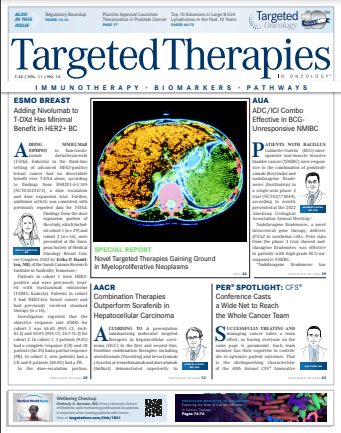Level of ER, PR Positivity Correlates With Improved PFS in Metastatic Breast Cancer
The phase 3 PADA-1 trial revealed a correlation between estrogen receptor- and progesterone receptor-positive metastatic breast cancer and prolonged progression-free survival.

Findings from a exploratory analysis of the PADA-1 trial (NCT03079011) revealed that progesterone receptor (PR) status is a strong prognostic factor and remains an independent factor in multivariate analysis in patients with metastatic breast cancer (mBC) who were treated with an aromatase inhibitor (AI) and palbociclib (Ibrance).
Further, having an estrogen receptor (ER) immunohistochemistry (IHC) greater than 80% resulted in a median progression-free survival (PFS) of 30.3 months.1
Results were presented by Thibault de La Motte Rouge, MD, MSc, during the European Society for Medical Oncology Breast Cancer Congress 2022.
“We know that level of ER and PR positivity is associated with response to endocrine treatment,” de La Motte Rouge, an assistant professor in the Department of Medical Oncology at Pitié-Salpêtrière Hospital in Paris, France, said.
The phase 3 PADA-1 trial evaluated 1017 patients who received an aromatase inhibitor (AI) and palbociclib (Ibrance) as first-line therapy for ER-positive, HER2-negative mBC. The objective of the trial was to evaluate if the level of ER and PR positivity was associated with response to endocrine treatment.
Patient and tumor characteristics showedthat 25.1% of patients were premenopausal, 38.8% had de novo metastatic disease, and 54.1% had visceral metastases. Regarding tumor characteristics, 73% of patients were ER/PR positive, and 26% were ER positive/PR negative.
The exploratory objectives of the trial included ER, PR, and HER2 levels with PFS and were assessed based on the Allred score,2 which is the percentage of cells that stain positive by IHC for hormone receptors on a scale of 0 to 5, plus the intensity of that staining on a scale of 0 to 3. The highest possible score is 8. Twenty percent of tumors with an Allred score of 2 or 3 respond to endocrine treatment. Lead author de La Motte Rouge said that the proportion increases to 50% in tumors with a score of 4 to 6 and rises to 75% to 80% in tumors with a score of 7 or 8.3
“In this exploratory analysis of PADA-1… ER, PR, and HER2 were locally assessed on the primary tumor sample but in one-third of the cases, it was assessed on metastatic tumor samples,” de La Motte Rouge said. Findings from PADA-1 were originally presented at the 2021 San Antonio Breast Cancer Conference.4
When evaluating PFS by ER subgroups, findings revealed that ER expression of 50% or less resulted in a median PFS of 16.6 months (95% CI, 10.8-25.1). If ER expression was between 51% and 80%, median PFS was 22.9 months (95% CI, 18.6-27.8), and if ER expression was greater than 80%, median PFS was 30.3 months (95% CI, 27.8-33.5).
“The Allred score, combining hormonereceptor expression and intensity of staining, confirms the predictive effect of higher score on PFS in patients treated with AI and palbociclib,” de La Motte Rouge said.
PR positivity between 51% to 80% (n = 185) had an HR of 1.93 (95% CI, 1.42-2.49). Investigators reported that PR expression of 50% or less resulted in an HR of 2.48 (95% CI, 1.94-3.07). A HER2 IHC score of 0 had a HR of 1.40 (95% CI, 1.15-1.65).1
Investigators found that age, absence of visceral metastases or bone-only disease, percentage of PR expression, and HER2 1+/2+ status are independent factors that reduce the risk of progression and/or death among patients receiving frontline palbociclib and an AI.1
“A PR positivity of more than 80% identifies a group of patients achieving the longest median PFS of 42.6 months,” de La Motte Rouge said. “Further, ER less than 50% suggests that CDK4/6i plus AI remains a good treatment strategy in this population.”
Patients in the HER2-low cohort group had a better PFS with AI and palbociclib vs the HER2-null group.1 Looking ahead to future research, de La Motte Rouge identified a need to investigate whether ER and PR status correlates with increased ctDNA ESR1 detection.
REFERENCES:
1. De La Motte Rouge T, Frenel JS, Hardy-Bessard AC, et al. Association between ER, PR and HER2 levels and outcomes under palbociclib (pal) + aromatase inhibitors (AIs) as first-line therapy for ER+ HER2- metastatic breast cancer (MBC): an exploratory analysis of the PADA-1 trial. Ann Oncol. 2022;33(suppl 3):S200. doi:10.1016/j.annonc.2022.03.186
2. Harvey JM, Clark GM, Osborne CK, Allred DC. Estrogen receptor status by immunohistochemistry is superior to the ligand-binding assay for predicting response to adjuvant endocrine therapy in breast cancer. J Clin Oncol. 1999;17(5):1474-1481. doi:10.1200/JCO.1999.17.5.1474
3. Brouckaert O, Paridaens R, Floris G, Rakha E, Osborne K, Neven P. A critical review why assessment of steroid hormone receptors in breast cancer should be quantitative. Ann Oncol. 2013;24(1):47-53. doi:10.1093/annonc/mds238
4. Bidard FC. Fulvestrant-palbociclib vs continuing aromatase inhibitor- palbociclib upon detection of circulating ESR1 mutation in HR+ HER2-metastatic breast cancer patients: Results of PADA-1, a UCBG- GINECO randomized phase 3 trial. Presented at: 2021 San Antonio Breast Cancer Symposium. December 7-10, 2021. San Antonio, TX. Accessed July 12, 2022. https://bit.ly/3AKiDBc
